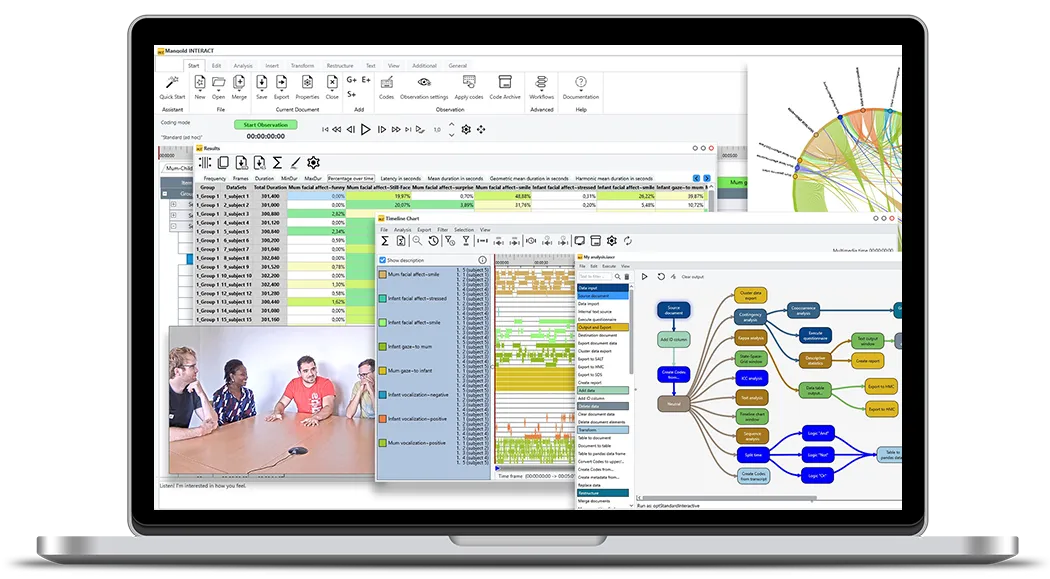Tutorial · 3 min read
Finding Co-Occurring Events in INTERACT - A Complete Tutorial Guide
Learn how to use INTERACT’s co-occurrence analysis to automatically detect and code overlapping behaviors, saving time and improving research accuracy.
Finding Co-Occurring Events in INTERACT: A Complete Tutorial Guide
If you’ve ever tried to analyze complex human behavior, you know how difficult it can be to capture and code every interaction accurately. Fortunately, Mangold’s INTERACT software makes it easier by allowing you to detect co-occurring events—moments where multiple codes overlap in time. In this tutorial, we’ll walk you through how to use INTERACT’s Time Sequence, Co-occurrence feature to identify these overlaps and create new event codes automatically.
Why Co-Occurrence Analysis Matters
Human behavior is often a combination of multiple smaller actions happening simultaneously. For example, if you want to study situations where two participants smile at each other, you need to capture both their facial expressions and their gaze direction at the same time. Manually coding these interactions is extremely time-consuming, but INTERACT can automate the process in just a few clicks.
Step 1: Open the Demo File
We’ll use the pre-installed demo file “mum-child still-face study”. This dataset contains 30 mother–child sessions with facial affect and gaze direction logged for both participants. Since the required data is already present, we can immediately start searching for co-occurrences.
Step 2: Launch the Co-Occurrence Routine
- Switch to the Analysis tab.
- Select Time sequence → Co-occurrence.
- In the first dialog, keep all sets selected to analyze all sessions at once.
- In the second dialog, choose the codes you want to overlap. In this case:
- Mother’s smile
- Child’s smile
- Mother looking at child
- Child looking at mother
Pro tip: INTERACT uses AND logic, meaning all selected codes must occur simultaneously for a new event to be created. Selecting too many codes at once may yield no results.
Step 3: Create New Events
Before running the analysis, check the option “create events from detected fragments.” This ensures INTERACT generates new events wherever the overlaps occur.
- Assign a class name—here we’ll use “Co-occurrences”.
- Assign a code name—let’s call it “smile at each other.”
Click OK, and within seconds, INTERACT will generate the results. In our example, the software created 398 new events — something that would have taken hours to code manually.
Step 4: Verify the Results
To confirm everything worked correctly, visualize the results with a Timeline Chart:
- Go to Analysis → Evaluation → Timeline Chart.
- Select the original smile and gaze codes, plus the new “smile at each other” code.
- Choose a single set for easy verification.
On the chart, you’ll see your new code appear only when all four behaviors overlap. This ensures accuracy and makes it easy to confirm the reliability of the results.
Step 5: Use the Data in Your Research
Now that the “smile at each other” fragments exist as regular events, you can:
- Run full statistics on them.
- Use them in other analysis routines.
- Combine them with different codes relevant to your research.
Final Thoughts
Co-occurrence analysis is one of INTERACT’s most powerful features. It saves time, ensures accuracy, and allows researchers to focus on interpreting data rather than logging it manually.
This tutorial used smiles and gaze direction as an example, but you can apply the same method to any combination of behaviors in your study.
Video Tutorial
👉 Watch our full YouTube tutorial for a step-by-step demonstration, and don’t forget to like, subscribe, and explore our other Mangold INTERACT tutorials for more tips on speeding up your research.
For deeper dives into Timeline Charts and descriptive statistics, check out our other tutorials.
INTERACT: One Software for Your Entire Observational Research Workflow
From audio/video-based content-coding and transcription to analysis - INTERACT has you covered.
